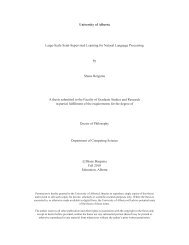The high altitude wildlife areas of western Arunachal Pradesh
The high altitude wildlife areas of western Arunachal Pradesh
The high altitude wildlife areas of western Arunachal Pradesh
You also want an ePaper? Increase the reach of your titles
YUMPU automatically turns print PDFs into web optimized ePapers that Google loves.
Mapping<br />
Chapter 3<br />
Vegetation and <strong>wildlife</strong> habitat mapping in the <strong>high</strong> <strong>altitude</strong>s <strong>of</strong><br />
Western <strong>Arunachal</strong> <strong>Pradesh</strong>, Eastern Himalaya<br />
Vegetation and topography together make up the basic ecological template defining<br />
the distribution and abundance <strong>of</strong> <strong>wildlife</strong>. In this chapter, we use ground data in<br />
conjunction with satellite imageries for the survey region to map different vegetation<br />
types represented in the <strong>high</strong>er elevations (> 2750 m) <strong>of</strong> Tawang and West Kameng<br />
districts. We also use these vegetation maps together with the information on<br />
mammal species richness (Chapter 2) and topography to delineate the tentative<br />
boundaries <strong>of</strong> the proposed <strong>high</strong> <strong>altitude</strong> <strong>wildlife</strong> reserve. We have provided the<br />
details <strong>of</strong> the field-methods, analytical techniques, and technical results <strong>of</strong> the<br />
mapping exercise in Appendix 5.<br />
Vegetation types and mapping<br />
Based on broad structural and compositional characteristics, the vegetation and<br />
landscape <strong>of</strong> the survey sites (elevational range < 2750 m) was classified into the<br />
following broad types:<br />
a) Permafrost (PMF): An elevation <strong>of</strong> 5250 m largely represented the upper limit for<br />
vegetation growth. Most <strong>areas</strong> above this elevation consisted <strong>of</strong> barren rocky or scree<br />
slopes and glaciers, and were classified as permafrost in our mapping exercise.<br />
We obtained locations using a GPS (top left) and took detailed notes on the vegetation. <strong>The</strong> <strong>high</strong>er<br />
elevations were dominated by High Altitude Grassy Meadows (top right) and Dwarf Rhododendron<br />
Meadows (below).<br />
19

















